Welcome to the week.
Here are the most notable stories our writers and readers have come across in the past seven days…
E-bikes for clunkers: As the quality and price of e-cargo bikes has gone up, perhaps it time to offer a financial incentive to people who want to trade in their older, gas-guzzling cars for a new electric bike. (The New Daily)
Fatality fault: Noted car culture critic Greg Shill offers four ways the federal government should regulate automakers so they being to think of “public safety” as something that pertains to road users, not just oversized car users. (Streetsblog USA)
Real mobility hubs: Portland could learn a thing or two from Berlin where their transit operator has created a new app that combines all types of shared vehicle sign-ups into one place — with physical locations to match. (Bloomberg)
Highway widening chronicles: When one of the most influential voices in American news has “widening highways doesn’t work” in a headline of a piece not in the opinion section, you know the Overton Window has shifted. (NY Times)
Pricing over pavement: A smarter way to create a more efficient I-5 would be to charge drivers more to use it and then invest that money into public transit. (Willamette Week)
Infrastructure ecosystems: Cities do themselves no favors by building bike lanes, sidewalks and train lines unless they’ve done the deeper work to make sure people will actually use them. (Strong Towns)
Perils of big EVs: “Automakers’ focus on large, battery-powered SUVs and trucks reinforces a destructive American desire to drive something bigger, faster, and heavier than everyone else,” says David Zipper in his latest article. (The Atlantic)
Wasted money: This investigative story argues that some EU countries are using funds earmarked for cycling infrastructure to no positive effect because it’s not being spent to build a high quality, connected network. (EU Observer)
Change is hard: While there’s a growing realization that billions on highways is bad for America, DOTs just can’t quit the habit. (Washington Post)
E-deaths: Let’s compare and contrast how government regulators respond to a report on e-scooter and e-bike deaths versus evidence that oversized SUVs and trucks kill many more people. (Fox News)
Nasty collision: A Portland bike courier is currently on the mend after being involved in a collision with a driver who was allegedly going the wrong way. (Fox 12)
Thanks to everyone who shared links this week.


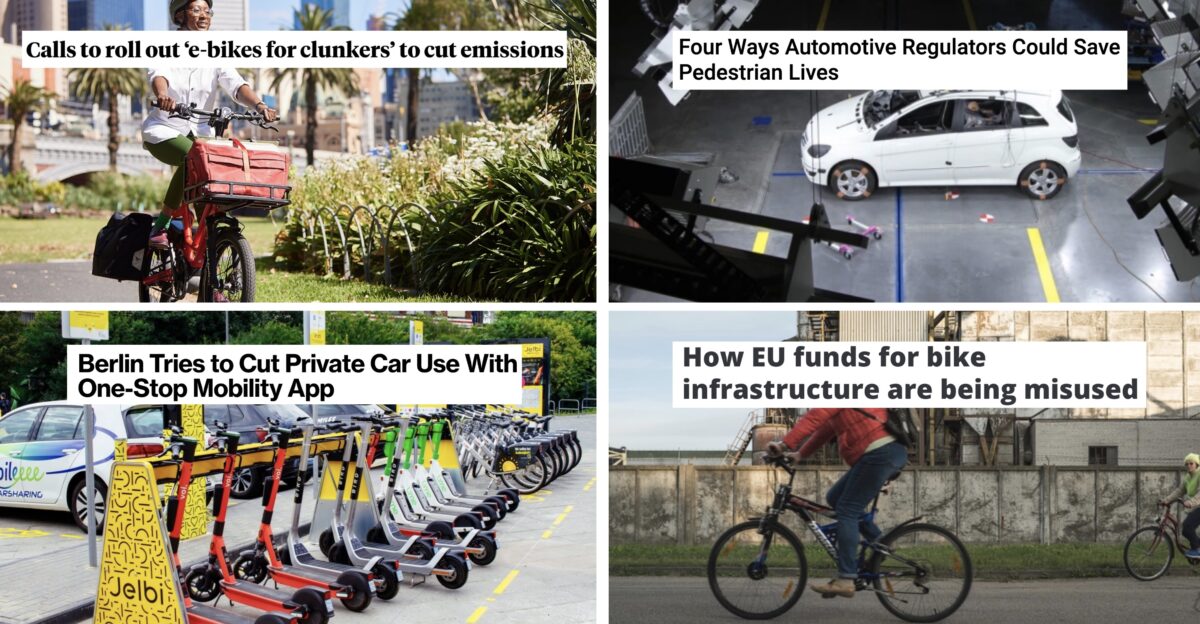
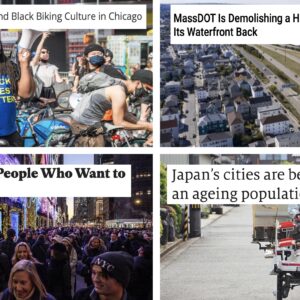
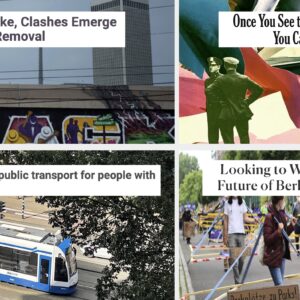
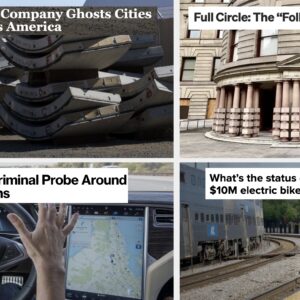
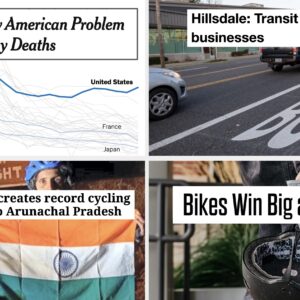
Thanks for reading.
BikePortland has served this community with independent community journalism since 2005. We rely on subscriptions from readers like you to survive. Your financial support is vital in keeping this valuable resource alive and well.
Please subscribe today to strengthen and expand our work.
Just so weird that for that last link about the hospitalized courier the wrong-way driver detail was almost a throw away detail. There was no mention of the driver staying on scene. No talk about whether the driver’s insurance would cover the damages. Nothing. Just simply that a driver turned out the driveway the wrong way, sent the rider over the car, and was never mentioned again. Talk about car blindness – the news can’t even see the car at all.
Per the victim’s GoFundMe page (Link in the news story) the driver was unlicensed and uninsured.
“Since the elderly woman who hit him is uninsured and unlicensed, Jake does not want to press charges or cause hardship on her for this mistake and is looking for his community to offer support during this challenging time.”
Great. So she’s still out there-a ticking time bomb waiting to go off and take out some other unsuspecting cyclist, pedestrian, or driver. I am much less inclined to contribute to the guy’s go fund me knowing that his inaction is preventing the police from getting a dangerous driver off the road.
I’ve almost been run over in the Rosa parks bike lane near the intersection with interstate on more than one occasion by people suddenly and unexpectedly shooting their cars into the bike lane. That area is hazardous. This is a missed opportunity to make it less so.
I can’t with good conscious support someone who chooses to leave a dangerous driver unpunished, unleashed on our community to injure or kill again. They need to take her car and crush it into a cube.
Exactly my point. None of that was covered in the Fox 12 piece.
I was really pleased to see the shift in tone from nytimes over the past couple of months. Looks like they have been reading Strong Towns and finally realized how they have had a car-culture implicit bias that has affected their reporting.
I hope other major news sources will change as well, although I don’t have much hope for fox news. Especially considering that idiotic article about e-mobility deaths. I wonder what the venn diagram of people who experience road rage daily and read fox news daily looks like.
The Strong Towns article highlighted is a little odd to me. For starters, the author is comparing downtown Santa Fe (founded in 1607) to a suburban area of Albuquerque – which is a bit weird. I mean of course the second oldest city in the country will be more walkable than a random suburban area of Albuquerque!
It’s of course important to consider the local areas around stations, and to give them the love they deserve. But like… the station she is talking about is just a stop between Downtown ABQ and Santa Fe on a service that is still relatively new and not that frequent. Land use reform probably wouldn’t make the area she is talking about in ABQ a transit paradise overnight – but having the transit service might give enough of a reason to make things better (albeit too slowly).
The work to make cities better for people involves land use reform, better transit, and safer streets. It’s not just one!
It also involves getting the people who live there on board. When locals support things, it’s much easier to make things happen than when it’s some outsider trying to impose their vision of “progress”.
It’s a clickbait title and a regurgitation of fundamental concepts to Strong Towns – but from what I can tell the target audience are car-advocates.
Why should a downtown stop be more walkable than a suburban stop? Yes, that is the way things are in America – but that is what is wrong. What was needed was actual urban planning – a design for the area that played to the strengths of its proximity to a rail line. Instead it was a park-and-ride. Instead of planning a proper transit, sidewalk, and bike network around the stop it was decided to put a sea of the lowest possible value land use around the transit stop – parking. This was not because people love driving to go get on a train, but because we were never actually providing train service. The goal was to reduce car traffic from the roads, a model for transit planning that has AFAIK never been successful. You should design a train line to be a train line, not a supplement to car infrastructure.
Why should a downtown stop be more walkable than a suburban stop? Because we have 100 years of car-oriented land use to design around. At least Downtown Albuquerque has a grid, some denser housing, and a semblance of real place. Frankly, it would have been insane for anyone to design a “station community” around a train that runs 6 times a day or so in the middle of an industrial area. We can start with the easier areas (say, downtown) that will deliver more value for more people first I think.
It’s a (relatively) cheaply built rail service on a disused freight ROW, the primary land uses abutting have historically been industrial. I don’t think the goal was to reduce traffic in the typical sense, considering Albuquerque doesn’t really have crazy traffic anyways. It’s about providing an alternative method to get between the two most important cities in the state, and I think it does a decent job of that.
Land use issues in suburban America are critical, but it’s an unfair criticism of the Rail Runner specifically to expect a walkable, bikeable, urbanist paradise around a random stop in an industrial park.
Indeed, Albuquerque’s 2017 comp plan designates the area around Montaño station for higher-intensity, mixed-use development with high-frequency transit. I’m all for maximizing transit investments, but TOD is real. Especially in less wealthy cities, the majority of the time the government is going to need to make concessions to developers to get the kind of development they want rather than vice versa.
I appreciate that the author of the piece took the time to connect their experiences to urban planning concepts and write about it. But it would have been a more interesting piece if she had taken 5 minutes like I did to see if the city was engaging in the planning processes she was calling for and write about that.
I’m not overly familiar with Albuquerque (although I have been, and had the best breakfast burrito of my life by a wide margin there for like $6), but I think they really need to improve the level of service in general before much TOD will really make sense. I mean the Rail Runner is cool, but runs like 6 times a day. They have a well designed BRT system which runs three-ish routes every 15 to 20 minutes most of the day (down Central Ave), so I feel like that is probably a more natural area for more intensive development.
The Montaño station has one bus that runs every 20-30 minutes, plus the train. Hopefully they increase bus service to the area with the new developments as well, or do something more with the Rail Runner ROW – the state of New Mexico owns the tracks.
The Fox article about the wrong-way driver in the bike lane who hit a cyclist is really disappointing. The point seems to be “Oh well – accidents happen.” But the driver was at fault for destroying the courier’s livelihood – his bike – and almost took his life! Are there NO consequences for the driver? Why did the reporter not even bother to highlight that angle? What did the police say? Was the driver cited in any way?
What any non-cycling reader of that article will take away is something like “Cycling is really dangerous so you better not do it.”
Even setting aside the possibility of a ticket, there will almost certainly be consequences. If the collision was deemed accidental (i.e. no intent to injure the cyclist), the driver will still have to pay compensation for the damage they did, which will likely be recouped in higher insurance payments moving forward. Hopefully they have enough insurance to ensure the courier gets paid a just amount.
And yes, in any complex system depending on the focus and attention of humans for long periods of time, accidents are going to happen. There’s things we can do (and much we have done) to reduce the likelihood and severity of those accidents, but they’re inevitable.
And yes, cycling is dangerous (compared to staying at home). So is driving. So are ladders and power tools and skiing and lots of other stuff we do. Be aware of the danger and take appropriate steps to minimize it.
You are giving way too much benefit of the doubt to both the system and the person that was driving the car.
The person was driving an unregistered and uninsured vehicle. It sounds from the go fund me description that the person was not cited by the police because the cyclist was sympathetic to the financial situation of the person driving the car. And the person intentionally and knowingly drove their car out of a driveway and into a curb protected bike lane, traveling in the wrong direction at a high rate of speed, without looking first to see if any bicyclists were oncoming.
This was no accident, and there will be no consequences for the driver.
Yes, cycling is dangerous, but the actions of this reckless driver are egregious and not within the realm of normal, reasonable actions of an inattentive driver.
It’s hard to know when we’re talking in general terms, both us with a list of unspoken assumptions (likely differing) we’re using to fill in the many blanks in the scenario we’re each imagining.
I think we agree that there should have been a citation or even an arrest in this case (based on the facts you presented, including intentionality and lack of insurance that I did not see in the story). As to why it didn’t happen, you make it sound like the victim asked them not to. I don’t know what to think of that, to be honest. Maybe the police should have ignored what the victim wanted, or maybe they were right to be deferential. I can honestly see it both ways.
So this might not be the best example around which to have this conversation.
Instead of knee jerk opposition to EVs those who want livable cities should be advocating for small EVs, neighborhood EVs, golf-cart-type EVs, and 2-3 wheeled EVs*. It’s very concerning that there are only two small and relatively light-weight EVs^ for sale in the USA and that so few people are advocating for smaller and lighter types of EVs.
*Many e-cargo bikes fit in this category
^Nissan Leaf and Chevrolet Bolt.
I’m hoping these actually make it to the US.
https://www.citroen.co.uk/ami
Citroen AMI
Does anyone have expertise on what it would take–legally speaking–to make these street legal in Oregon and/or United States?
It’s my sense that there is a large portion of our urban citizens who want to transport themselves in a more environmentally conscious way, but simply cannot see themselves taking transit (for all the reasons we all know are cited) and either don’t have the ability or can’t/won’t be exposed to the elements while riding a bike. Perhaps a micro EV is an option: smaller carbon footprint to build and use, significantly safer for pedestrians/cyclists, and a smaller physical footprint for storage.
The Gem EVs are street legal so I think these would be street legal as a city car (max speed of 28 mph).
The problem is that corporations believe that USAnians simply do not want to purchase small cars.
Not to mention made-in-Oregon Arcimotos*, which look super fun to drive. I agree that most folx don’t want small vehicles like this.
*Ignoring the financial situation of the company.
I don’t know, but I saw Smart Cars in Europe first in 2003 and it was many years before I saw them in the states. My understanding is that by the time they were crash-test approved for US use, they had lost much of their power-to-weight advantage of being so small. And still, most people’s reaction is, “I wouldn’t drive one around big trucks.” Me? I love and always have loved smaller vehicles. They just make more sense, especially for urban/suburban use.
To tag onto the idea “E-Bikes for Clunkers” I wonder how successful, if at all, a “TriMet lifetime pass for Clunkers” program would be?